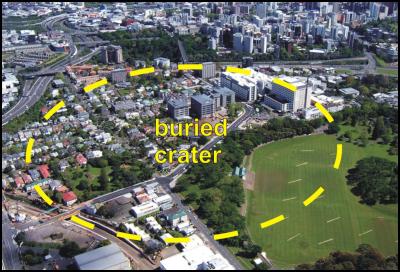Forgotten Ancient Eruptions In Auckland
New Research Reveals Forgotten Ancient Eruptions In Auckland

border="0">
Click for big
version
New research on Auckland’s
volcanic field has uncovered a volcano which had been all
but forgotten, and this work will better define what is
most likely to happen when the next volcano forms in
Auckland. The research is part of the Devora project, a
seven-year study to better understand the volcanic history
of Auckland and help prepare the city for a future
eruption.
By analysing records from boreholes drilled for foundations of buildings, roads and or for water supply, scientists have been able to identify a previously little-known volcano now hidden beneath the suburb of Grafton, close to the Auckland University Medical School.
Geologist Bruce Hayward, of Geomarine Research, put together the volcanic puzzle by linking lava flows between boreholes and measuring changes in the thickness of the lava flows and volcanic ash it is possible to identify a buried volcanic crater.
“The crater is about 1km across and filled with solidified lava flows,” Dr Hayward said. Auckland is built on the Auckland Volcanic Field, a group of about 50 volcanoes that have erupted over the last 250,000 years. Scientists believe that most of the volcanoes erupted only for a few months or years and then became inactive. However, our knowledge of exactly when each volcano erupted, and how future eruptions might progress is incomplete.
Close inspection of the second oldest geological map of the Auckland Volcanic Field, published by early explorer and geologist Ferdinand von Hochstetter in 1864, shows four volcanic vents in the vicinity of the Domain.
“So although this find is exciting, it is clear that Hochstetter recognised the presence of a volcano in this locality before it was covered in houses,” Dr Hayward said.
“It would appear that this Grafton volcano erupted just before the neighbouring Domain Volcano, more than 50,000 years ago.” A thick layer of volcanic ash from the Domain eruptions buried and hid the Grafton Volcano until recent boreholes have shown its full extent and nature.
Over the last few years, geophysicists at The University of Auckland have also been studying the rocks under Auckland using gravity and magnetic measurements. Because lava is very magnetic, airborne surveys of the city have revealed where lava is present underground, even where it is not visible at the surface.
One area of high gravity and magnetism is in the same area that Dr Hayward has identified the new Grafton volcano. Bringing together these different methods has helped to confirm the findings.
Joint Project Leader, Dr Jan Lindsay from The University of Auckland, said the new information shows that we still have a lot to learn about the past volcanic activity in Auckland.
Scientists hope to bring the borehole data from across the city into a central database where it can be used to model where past eruptions have occurred.
The Devora project is led jointly by GNS Science and The University of Auckland in collaboration with Massey University and brings together data and researchers from many different areas of study. The project is funded jointly by the Earthquake Commission, the Auckland Council, the Ministry of Science and Innovation and The University of Auckland. Project Devora, which stands for Determining Volcanic Risk in Auckland, started in late 2008.
END


 NZ Telecommunications Forum - TCF: Telecommunications Forum Warns Retailers About 3G Shutdown
NZ Telecommunications Forum - TCF: Telecommunications Forum Warns Retailers About 3G Shutdown PSA: Worker Involvement Critical In Developing AI For The Good Of Aotearoa
PSA: Worker Involvement Critical In Developing AI For The Good Of Aotearoa MBIE: Easter Trading Laws - Your Rights And Responsibilities
MBIE: Easter Trading Laws - Your Rights And Responsibilities The Conversation: As More Communities Have To Consider Relocation, We Explore What Happens To The Land After People Leave
The Conversation: As More Communities Have To Consider Relocation, We Explore What Happens To The Land After People Leave Bill Bennett: Satellite TXT expands, how Egmont Village got a fibre network
Bill Bennett: Satellite TXT expands, how Egmont Village got a fibre network Community Access Media Alliance: Proposed Spectrum Fee Increases Threaten New Zealand’s Community Access Media Sector
Community Access Media Alliance: Proposed Spectrum Fee Increases Threaten New Zealand’s Community Access Media Sector



